Ryn Shell's Blog, page 2
August 1, 2025
Apricot Roses In Green Vase by Ryn Shell
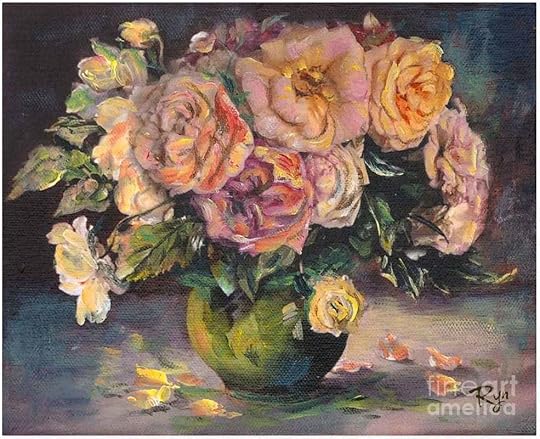
 The painting was completed in one setting, impressionist style, as a teaching demonstration, using Maimari Puro oils on 8" x 10" canvas panel board and only three tubes of colour.
The painting was completed in one setting, impressionist style, as a teaching demonstration, using Maimari Puro oils on 8" x 10" canvas panel board and only three tubes of colour.I have not signed this work as yet, as I like to spend some time looking at it before the final brush strokes go in.
Primary YellowPrimary RedPrimary BlueTitanium White Can you pick, straight away, which colour I altered from nature? I titled this painting Roses from a Friend as they were a gift to me from one of my students. The students watched me demonstrate this one step-by-step. As I have said before, one of the focuses of this lesson is to think of tone and shape more than colour. You can alter the colour, and the painting will still work as long as the light and shade pattern is correct.
I illustrated my point that it doesn’t matter if you change a colour, as long as the light-and-shade pattern is correct, by changing the leaf colour from bright green to tones of gray.
Colour hue isn’t all that relevant as long as it is harmonious. In the next photo, the image of the painting has been colour-enhanced using a computer photo program to create blue-green leaves. The painting isn’t better or worse for doing that; it is just a different colour. The success of the painting is in the mastery of painting the correct tonal values in the correct shape and proportion to each other, or in having mastered tonal painting.
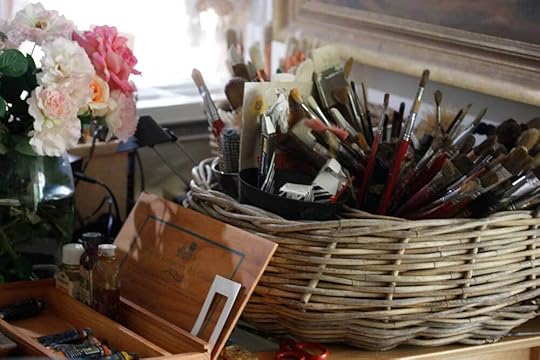
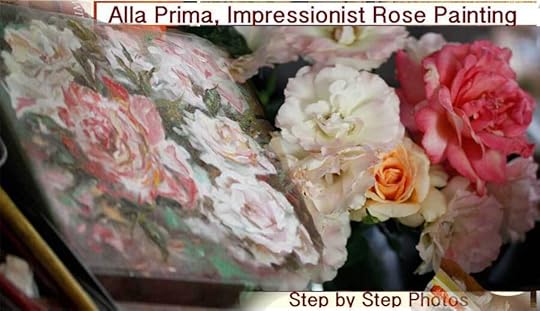
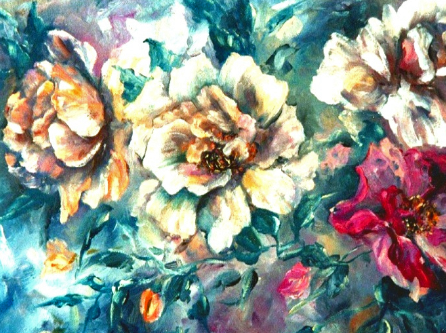
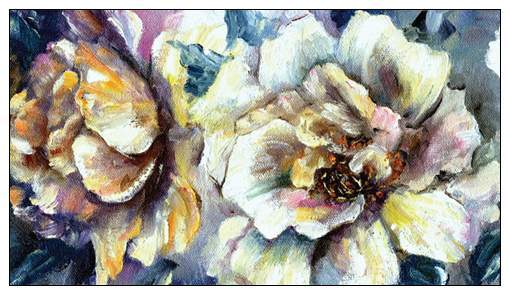

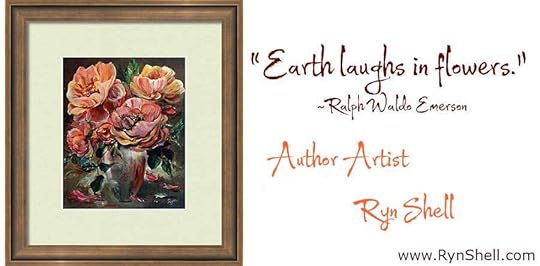
Published on August 01, 2025 07:00
July 31, 2025
Earning a Living as an Artist
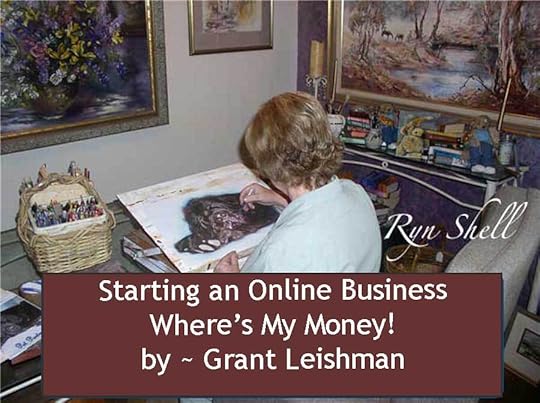 .Where’s My Money!
.Where’s My Money!So, you’re now up and running with your online business and it is time to sit back and watch the money pour in – but where is it going to pour into?
“My bank account, of course,” I hear you say.
Well, unfortunately, it is not always quite that simple. If you are running an online business you will potentially be dealing with people from all over the world, some of whom may have bank accounts, but many of whom will not. International banking is a complicated business and fraught with issues in these days of money-laundering scandals etc. Besides, the fees involved in international transactions can be extremely high, especially if your online business is selling low-value products. The fees could be more than the price of the product. Nobody will want to deal with that.
As an unknown supplier, you are also going to run into trust issues with your customers. How can they be sure if they pay you the money, that you’ll send them the goods? It can get pretty messy to be honest, so in my experience, the best solution is to use a trusted middleman. There are often plenty of organisations in your country that will facilitate a payment system with international clients, but in my experience, the most trusted, easy to use and one of the biggest is PayPal. Now, PayPal has been around for close to 20 years and it is well established, highly trusted and in my experience very easy to deal with.
Setting up a PayPal Account is simple and something I would recommend you do immediately you start your online business. Just go to their website www.paypal.com and join up. They prompt you in all the right places so you set up exactly the type of account you will require. Two things I particularly like about PayPal are; 1/ They allow you to issue invoices direct to your clients and 2/ You have a permanent record of all your sales, for income tax purposes etc.
 Like all these systems, they want their share of your transactions, so there are fees involved in most transactions. I think it is 5% of the net payment, which isn’t too bad for the convenience they provide. You can also receive payment in any currency and they allow you to convert that to your local currency (always, of course, taking their little slice of the action along the way).
Like all these systems, they want their share of your transactions, so there are fees involved in most transactions. I think it is 5% of the net payment, which isn’t too bad for the convenience they provide. You can also receive payment in any currency and they allow you to convert that to your local currency (always, of course, taking their little slice of the action along the way).You can easily withdraw your funds from PayPal in one of two ways. You can have it transferred to your local bank account. (They only charge a fee for this if the amount is below their relatively generous threshold) and the money takes only a couple of days, usually, to find its way into your bank account. The other option is to have your money transferred to a VISA card (note: only VISA – no other cards at this time). It is a nice easy way to get your money out of your PayPal account.
So, we’ve sorted out how to get your money to you, but how about paying for things online yourself? Many people either don’t have a Credit Card or are loath to use one online because of the inherent risks involved. PayPal can be extremely useful here also. Many websites accept PayPal as a payment option, so problem solved – as long as you have enough of the currency required in your PayPal account. They will convert your currency for you, to the required denomination, but of course, there is a fee involved. Their rate of exchange will be less than that advertised in the market. The other option is to get yourself a bank or other pre-paid Debit Card. These cards can be loaded with funds, in advance, and used just like a Credit Card, online. The two main cards available are a VISA or a MasterCard. Given PayPal’s preference for VISA, that’s the one I would recommend you use, as you can load it directly from your PayPal account.
So, that’s pretty much the easy way to handle those millions that will now be rolling into your online business, but before I go, I’d just like to relate a small anecdote to give you some idea of how convoluted running an online business can be from the perspective of international payments.
Now, I live in the Philippines, which has a banking system that is, shall we say, considered a little suspect by the rest of the world. At the moment, my main product is my books, which sell exclusively on Amazon. Now Amazon won’t pay directly to a Philippine Bank Account, so I have had to ask a friend to set up a bank account in the U.K. for my royalty payments from Amazon. So, each month, Amazon pays US$ to my British Bank Account, which then converts the dollars to British Pounds. My friend then transfers those funds to her PayPal account and transfers them to my PayPal Account, where I then have to change the British Pounds into Philippine Pesos, to transfer them to my Philippine Bank Account. At every step in this process, the bank or PayPal takes their little share – a whole lot of little shares soon add up, though. But, that’s the way it is and I have to live with it. Oh for the day when Amazon pays out to PayPal direct. I suspect eBay owning PayPal may have something to do with Amazon’s unwillingness to use PayPal for its royalty payments. Ah well, such is life!
Next time, I’ll talk a little bit about building your brand and getting your product/service out there and noticed. The “fun” part of online entrepreneurship – marketing!
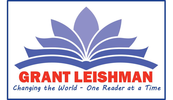 GRANT LEISHMAN
GRANT LEISHMANAUTHOR, BLOGGER AND EDITORIAL REVIEWERI am an expatriate New Zealander, now living in the Philippines with my beautiful wife and two lovely daughters. At age 55, after careers in Journalism and finance, I finally discovered my true passion in life – writing. I am now a full-time author who has written or co-written seven novels, across differing genres.
My latest project is a Historical Romance set to the backdrop of the Philippine revolution of 1896, against the Spanish.
I believe in the power of the written word and the mantra that I live by and finish each of my blog posts on my website with is: CHOOSE TO BE HAPPY!
EMBRACE THE OPPORTUNITIES LIFE PRESENTS TO YOU AND ALWAYS, ALWAYS FOLLOW YOUR DREAMS!
HAVE A GREAT LIFE AND SPREAD THE LOVE!
CHANGING THE WORLD – ONE READER AT A TIMEEarning a Living in the Arts
To earn a living in the arts you need to be able to create a traffic stopper.
You must captivate an audience, stop passing foot traffic in its tracks and rivet them on the spot, looking at your artwork.
It might be the due to the beauty or the excellence, which are the ideals I aim for I art. Some will strive for entertainment or shock appeal. Whatever your choice is, if you artwork cannot stop the passing traffic, it won’t sell.
The only way to know for sure your art will pass the traffic stopper test is to exhibit often to targeted buyers. If your potential market responds, and is drawn to the work, then you have achieved that traffic stopping success, and if all other aspects of presentation are right, clients will buy your artwork.

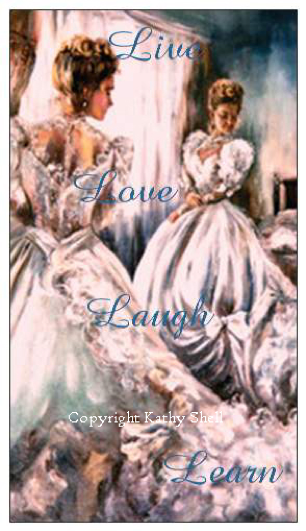 Believe in Your Artwork.
Believe in Your Artwork.Maintain Your Integrity and Calm.
There are Discerning Clients.
In the current computer age many people print out a photo and then colour it in parts and pass that off as portrait artwork. No wonder the ethical and trained artist has difficulty in finding people who appreciate their artwork when the untrained eye cannot pick a coloured in photo from a 100% genuine original painting.
A customer once purchased this lovely card I’d made from the print of my daughter Carla on her wedding day. I priced the card reasonably at $2. On paying me and receiving the card, she turned to her friend as said, ‘Look, an original oil painting, and it was only two dollars.’
You have to toughen up to be an artist.
Well, I am not a con-artist. I had distinctly called it a reproduction card. That information was also printed clearly on the back of the card. I didn’t want her to misunderstand, so I explained clearly, in a friendly and polite manner, that it was a print from the original. When I explained this, she threw the card at me, yelling that it ‘was only a print’ and that she was ‘highly offended.’
What? I took a deep breath and smiled sweetly. She was offended that I had not sold her an exquisitely detailed, miniature, original painting for two dollars?
I refunded the two dollars, bit my lip and did not say that I, as the artist of the original oil painting, was highly offended that she had expected the original for the cost of a print card. What would be the point of trying to explain the reality to her? This print represented forty years of training and experience and two hundred hours of labour or four weeks of full-time labour. It’s best to just laugh about it with those who do understand and to realise that this example will only be one of many such situations you will come across where you as an artist or your work will be insulted.
There is a gulf between the reality an artist knows and what many people may think is the value of an artist’s labour. Just don’t pander to that mentality. Maintain your pride in your work and belief that the right person will come along who loves the art you create, appreciates your labour and is happy to pay for quality art.
Many artists carry within them the small wounds that come from feeling undervalued. I am telling you this because once you step out and declare yourself a professional artist, writer, musician or any creative person in the arts, you will be expected to create with the skill of an ‘old master’ for the fee of a speed painter by many people.
You will struggle not to become disheartened when you see mass production work made in factories being sold as originals for prices that you know you could not purchase quality paint and canvas to produce the item.
Hang in there; hold your head up and maintain the integrity of your artwork. BELIEVE. Believe in yourself. Believe in your artwork. You are not trying to paint to please everyone; you are painting to please yourself, and the right client will appreciate that you have artistic integrity and used the quality archival materials that last.
If you get frustrated and feel unappreciated for your artistic endeavours, just remember that I had a customer who expected an original portrait of a woman in a wedding dress with a double image in a mirror for two dollars and have a laugh.
You have to toughen up to be an artist is repeated in several other Art Studio eBooks, including The Business of Art.
Keep up your training; keep up your spirits. I understand this can be difficult in an age when most people assume that artists cannot paint like the old masters. The reality is that not many clients are prepared to pay the true value of the labour needed to produce a masterpiece of the standard of the artwork shown next, that of Marie Antoinette at age thirteen.
A good artist who constantly exhibits his work before the public and prices it fairly will sell. This is not a get-rich-quick profession. If you provide a service for your clients, promote your work and charge a reasonable fee for quality service, there is work for honest portrait artists.
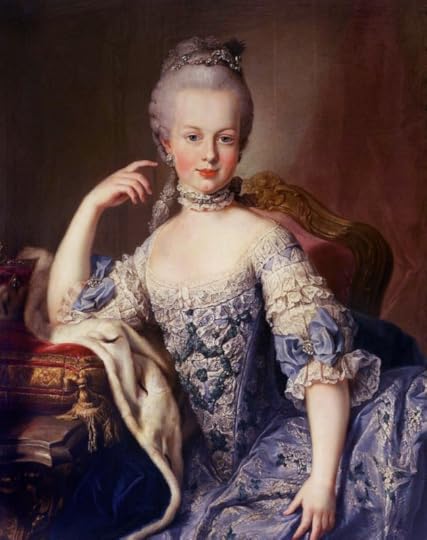
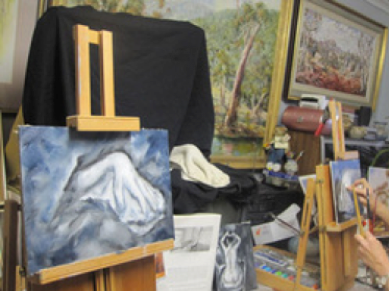 A wax model was made from Marie Antoinette’s hand. From that original impressing, plaster casts were made.
A wax model was made from Marie Antoinette’s hand. From that original impressing, plaster casts were made.
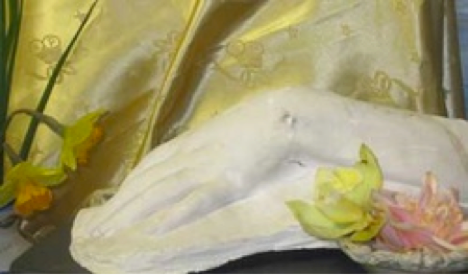 These plaster casts of Marie Antoinette’s hand have found their way into artists’ studios, including mine. Note the form of her hands and compare them to those of the adult Marie Antoinette in this plaster cast.
These plaster casts of Marie Antoinette’s hand have found their way into artists’ studios, including mine. Note the form of her hands and compare them to those of the adult Marie Antoinette in this plaster cast.
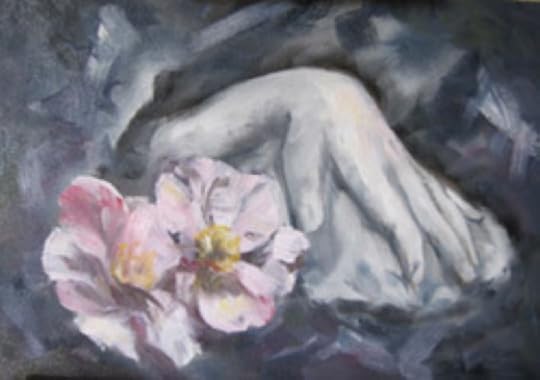 It is on light and shade, tonal value exercises such as the above and those to follow that artists gain their traditional training for portraiture painting.
It is on light and shade, tonal value exercises such as the above and those to follow that artists gain their traditional training for portraiture painting.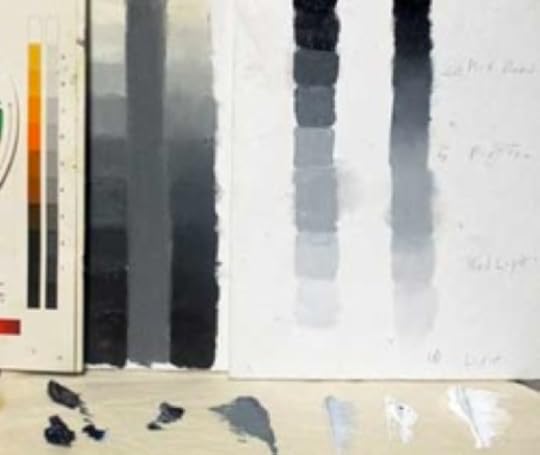 Alan Martin had me begin my portraiture training by painting black and white and grey squares and mastering my ability to see tones and shapes. This is good discipline training. I always warm up to doing any major work of portrait art by starting with these tonal practice stages. Most traditionally trained artists continue to paint these tonal exercises though their lifetime.How to Price Your Artwork
Alan Martin had me begin my portraiture training by painting black and white and grey squares and mastering my ability to see tones and shapes. This is good discipline training. I always warm up to doing any major work of portrait art by starting with these tonal practice stages. Most traditionally trained artists continue to paint these tonal exercises though their lifetime.How to Price Your ArtworkHow much is a painting that size worth?
I’ve been asked that a few times.
How long is a piece of string?
You can see the training required to develop your eye to see tone and shape. After mastering these skills, you must study paint chemistry and practice the technique of applying a clean edge or a blended tone to a section of a painting. Then there are the years of practice necessary to produce a truly beautiful flower painting, such as the one below from a gallery I once managed.
Before purchasing artwork (especially if buying online) beware of fraud.
A painting may be a real investment artwork from an old master. But it could be a screen print on canvas with a slap or two of paint, as most sold-online paintings are. If you saw a painting on feebay from an unknown dealer, would you be able to differentiate a legitimate work of art from a cheap imitation? I am not saying that you cannot buy quality artwork online. As a matter of fact, online is the primary channel I use to sell my work. I simply want you to make sure you are dealing with a reputable dealer if you are seeking investment-quality artwork.
Be aware that there is a style of rose painting called folk art that takes a fraction of the time of fine-art painting. With this style, roses are stylised, not painted in the fine art way that I teach. Obviously, stylised painting is craft painting and, unless accompanied by marketing bull..., should be marketplace and home decor, affordably priced.
Formulas that might work for pricing work.
Price by Quarters method.
1/4 Raw materials cost.
1/4 Overheads
1/4 Advertising expenses or Exhibition fees.
1/4 for Artist's Living Wage.
So, if you need $25. in your county for a living wage, you would need to charge $100. per hour. If $25. an hour equals the costs of the raw materials, the overheads and exhibition advertising or commission cots, that might be a correct price. Here are two examples where that formula might work.
Leading artist: Painting priced at $1,400.
Quality Belgian linen stretched canvas and the worlds best quality paints and a premium quality frame. The total wholesale cost to artist $350.
Premium exhibition venue rental and adverting divided by sales $350.
Overheads and expenses as painting sales per year divided by annual overhead costs equal $359. per artwork. These overheads might be towards the cost of a computer, office supplies, travel for the landscape painter, the garden of a flower painter, camera equipment for a wildlife artist, plus studio lighting and air conditioning, ane an occasional assistant if required.
$350. x 4 = $1,400 for a quality work that takes the artist 14 hours to paint IF the living artist's wage in that location is $25. per hour and the value of the materials, overheads and expenses are all proportionate.
That formula, based on the above calculations, would be totally wrong for an artist using student grade paint, and a cheap chain-store canvas, none of which are archival value.
I'm using conservative figures here. An artist might be at the height of their profession and their work highly in demand. They might frame in hand-carved gold encrusted frames and display though high market, costly gallery space. They may need to charge $100. an hour to clear $100. an hour they may have clients happy to pay $4,000. for a painting that took ten hours to paint.
However, a speed painting created it an Asian sweatshop factory where the painter earns $3. per day to paint with cheap acrylic paint onto a poor quality screen printed canvas, to be sold in the Western world as an original oil painting, is worth—what?
These paintings are purchased by number for a few cents, if small, and for a few dollars each, and are then fobbed off on eBay and at markets as the original work of the seller, for a 1000% markup.
Shudder.
Don't ever attempt to compete at that level. Just paint with integrity, and exhibit where you believe there will be clients who can tell the difference and don't expect that the world owes you a living because you chose to become an artist. Being a professional artist is extremely hard work involving long hours of work and no job security. The rewards aren't financial, they are in working a job that's your passion, a job that you love.
Commercial or Amateur Artist. Painting priced at $40.
If the art materials for the painting cost $10.
If the overheads to complete the painting are minimal, say $10.
If the exhibition fee is only an eBay listing cost and fee on sale, or a local market, barely a cost of $10. per painting sold, and the artist whacked the work together as a speed painting, or it is an amateurish work, of no more value than a speed-painting, then $40. might be a fair price for that work, especially if it represents a flung together, painted to a price, craft work, speed painting rather than a work of original fine art.
If the customer cannot tell the difference, don't bother trying to convince them why one work is worth more than the other. Fine art appeals to slightly less than 2% of the population. If you want to create and sell fine art, don't try to do it in a speed painter's marketplace and expect everyone to understand that you spent more on the canvas than the speed painter can sell their work for. You cannot paint to please everyone.
Price by size method
Once you have worked out your overheads and exhibition and raw materials costs, and how long it takes you to complete artworks of varied sizes, you may be able to work out a price per size for our work. If you were to paint similar works, each taking the same amount of time per inch to complete, then that method might work for you.
Calculate the painting size by length multiplied by width = size x by dollar value = price of painting.
Or.
Calculate the painting size by length plus width = size x by dollar value = price of painting.
With one of those methods there is a wider variation in price between your smaller and your larger paintings. I've heard artists who use the length plus width method say that they don't put that much more work into a large painting than they do a small painting. so those prices work for them.
12" x 16" = 192 x 7.5 (an average trained portrait artist's calculation) = 1,440. is not an unrealistic price for a skilled framed artwork of that size.
As my overheads are lower, but I use the wold's best quality materials and paint to a high standard and in a labour intensive way, I price as width inches multiplied by length inches, multiplied by five, equals my unframed artwork price, plus delivery costs.
 That makes a a 12" x 16" painting such as this one above, AU$960. direct from artist and unframed. Those are the prices I've charged for portraiture standard work, and had no difficulty getting for the past couple of decades. I generally will charge less if a painting takes me less time because it hasn't required the skill of a portrait artist. Most artists will have their art bargains, lovely works, still painted with integrity, but of easier to paint subjects that took considerably less time to paint.
That makes a a 12" x 16" painting such as this one above, AU$960. direct from artist and unframed. Those are the prices I've charged for portraiture standard work, and had no difficulty getting for the past couple of decades. I generally will charge less if a painting takes me less time because it hasn't required the skill of a portrait artist. Most artists will have their art bargains, lovely works, still painted with integrity, but of easier to paint subjects that took considerably less time to paint.
Published on July 31, 2025 07:00
July 30, 2025
Glass Inkwells
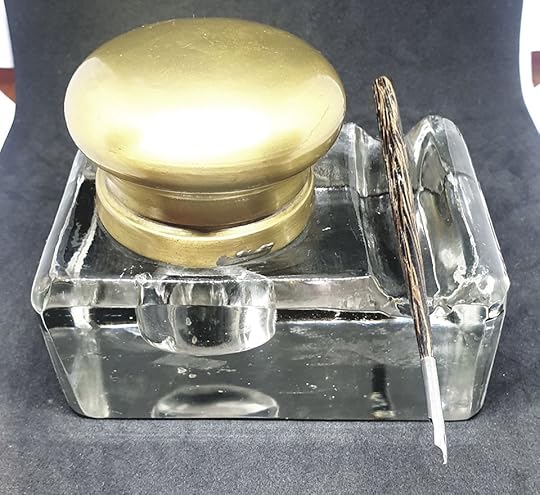 Hand made inkwell -purchased in France. Date unknown. The Meaning of Limited Editions and Special Editions
Hand made inkwell -purchased in France. Date unknown. The Meaning of Limited Editions and Special EditionsI've always been skeptical of Special Editions and vague Limited Editions. Take the The Franklin Mint's promotion of "Limited Edition", as something "limited to x amount of firing days," without revealing if there are fifty or fifty-thousand pieces of that designed item in the kiln, or even multiple kilns fired on each of those firing days. They certainly produced as many of each item as they believed they can saturated the potential market with. Nothing limited about that, just a sales pitch to make the items appear to be scarce.
You really do need to read the fine print and not just the advertising blurb.
A Limited Edition is usually a small, quality production run, with each item numbered with its number within the edition quantity, of an in demand item. The certificate is usually signed my the maker, for it to be of real value and not just a marketing gimmick.
Buying limited editions in the hope of getting a financial return might be more fun than buying lottery tickets and the odds, if you buy wisely, about the same.
 Hand made inkwell -purchased for Ryn Shell's 74th birthday. I have two beautiful heavy glass ones that I treasure. I use one to hold the tall bottles of Robert Oster ink if I am using it as I'd not dare take the lid off those bottles of ink otherwise. Have I mentioned I like squat bottles for ink? Occasionally, I will make ink soup in the other ink well if I want to evacuate unused ink from a pen. I usually use every drop of ink before refilling, and my ink wells are primarily decorative.
Hand made inkwell -purchased for Ryn Shell's 74th birthday. I have two beautiful heavy glass ones that I treasure. I use one to hold the tall bottles of Robert Oster ink if I am using it as I'd not dare take the lid off those bottles of ink otherwise. Have I mentioned I like squat bottles for ink? Occasionally, I will make ink soup in the other ink well if I want to evacuate unused ink from a pen. I usually use every drop of ink before refilling, and my ink wells are primarily decorative. 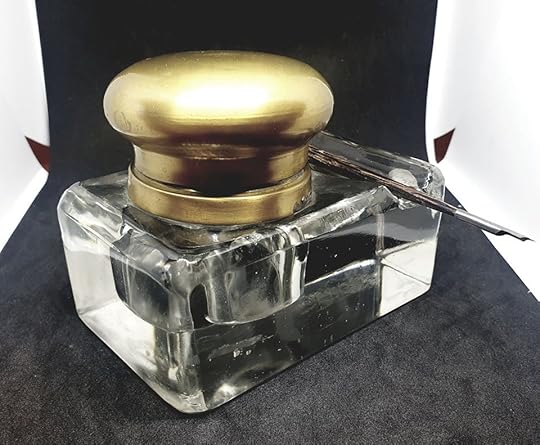 The Divine Discontent of Artists
The Divine Discontent of ArtistsI'll tell you a story I always told my advanced students.
Two artist's who'd known and admired each other's work for year met again after a long gap in time. They asked each other how their art was going and each was shocked when the other spoke about feeling they were not painting well. Both disbelieved that it was possible the other wasn't creating great art, so they agreed to view each other's latest works and honestly appraise it.
The consensus of opinion was, they were not painting badly, it was a case of their expectations had increased. One thing that trained art tutors stress is that you will never be 100% satisfied with any work. You have to leave it though, and put all you feel you learned from creating it and all that you'd have done differently if you could, into a future work.
Accept that if you did create perfection what a handicap that would be. You'd probably give up, knowing perfection isn't repeatable. Better to feel you haven't achieved what you are after as yet and keep trying for it.
The French art masters call it "mécontentement divin" The divine discontent, and believed t is normal for an artist to go through phases f hating the artwork they are doing, or even a body of work. Understanding that all artists suffer from this (I certainly do) helps.
Getting into the confident mood to move ahead believing you can do it is essential and we just have to do that. Your work is EXCELLENT. That horse was labour intensive to create, you look at it and remember some of the fatigue. in creating it and aren't as aware of the beauty of it as those who come across it—not seeing the hours of labour behind it.
Take care my friend. You are truly gifted.
My Vintage Glass Inkwell Collectable Finds
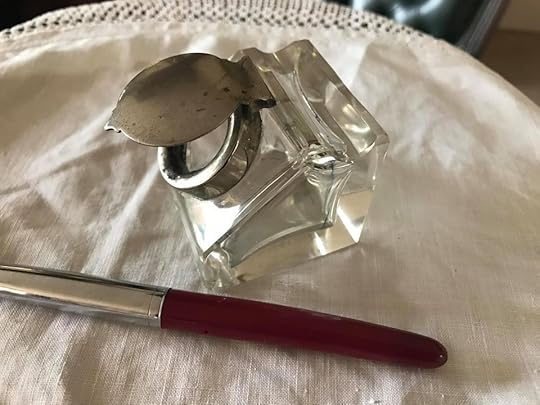 What pen preferences, if any have you developed over time? My preference isn't a brand it's a type. I prefer pre-owned or discounted, if I can get a better price for the quality that way. I would not pay over $500. and rarely pay more than $200.
What pen preferences, if any have you developed over time? My preference isn't a brand it's a type. I prefer pre-owned or discounted, if I can get a better price for the quality that way. I would not pay over $500. and rarely pay more than $200. I want a generous size piston fill, preferring a pop cap, but will tolerate a screw cap. As good price for quality performance in my main consideration I tend to own mostly black and gold trim preferred or classic coloured pens. I dislike bling and marbled plastic looking bright coloured pens. For a nib, I like a Japanese medium gold nib or German fine gold nib best but will go down or up one size from there for the right pen.
I once preferred lighter fine pens. I now, having learned how to glide the pen on the paper, I prefer a heavier weighted pen.
I have gone off vintage pens with bladders, and anything that doesn't have a generous size piston fill, plus all my light weight pens. I should do another sell up, but I still keep all my pens inked up and in use and don't wish to pay out more to have pens I'd prefer to the ones I have which do the work I need done adequately. I also try to avoid selling physical goods, it's inconvenient.
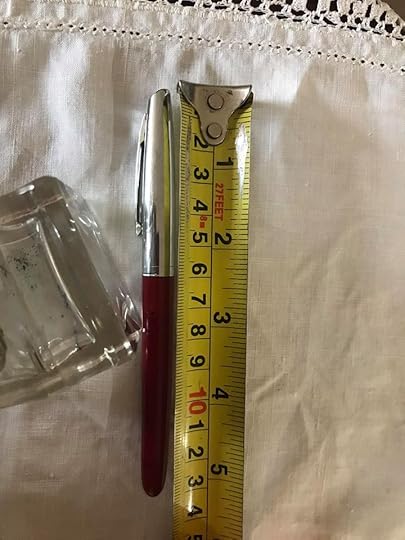 What to do when the Muse doesn't visit?
What to do when the Muse doesn't visit?To be a writer, you must write. You need a goal, an action plan to achieve the goal, and a to do list focused on the action plan.
Muses are optional.
The muse sees you at work and will often join you, which helps the words low faster. But the muse would rarely arrive and sit down to do the job with you. It’s persistence, not muses, that achieves success.
Set your goal, then create the action plan you need to do to achieve that goal, then just do it. One foot it front of the other on those days when it is hard to keep going. We all have an area in our lives where we need to, “Just do ti!”
It’s even okay not to write if you don’t want the goal enough to carry out the action plan. But, you can get through those slumps by just sticking with an action plan even when it’s difficult, if you want that goal enough.
Maybe ask yourself if you are chasing a goal that excites you enough to do the work.
There’s no failure in modifying or changing the goal to one that motivates you to do the work.

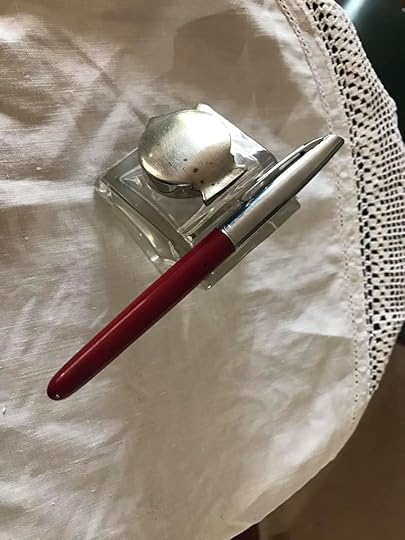
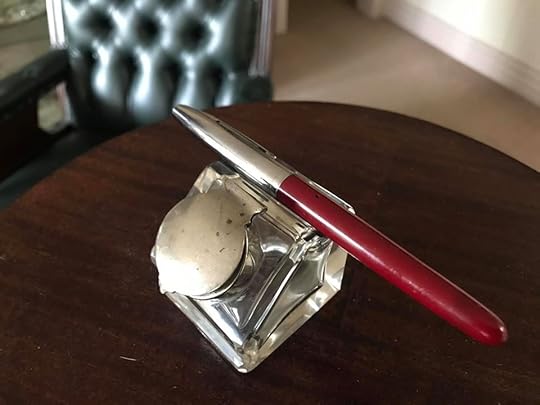
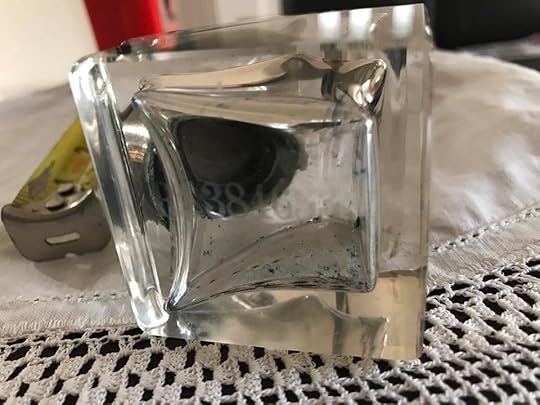
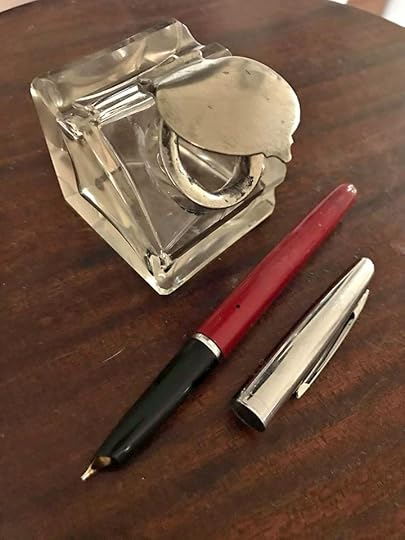
Published on July 30, 2025 07:00
June 30, 2025
Water birds and wallabies at the water's edge.
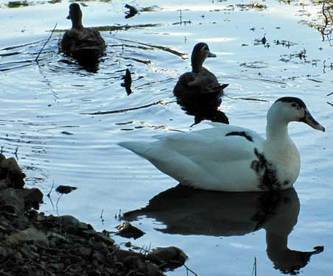
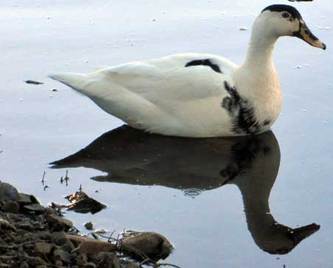
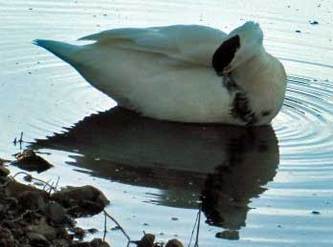
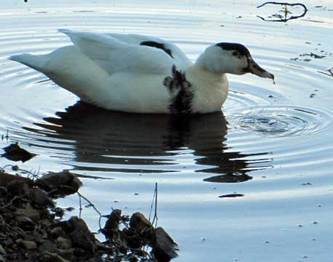
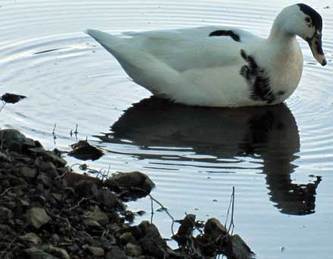
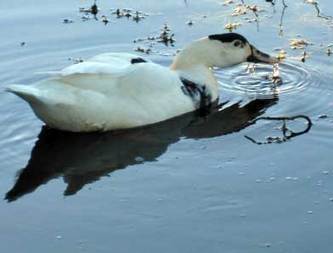

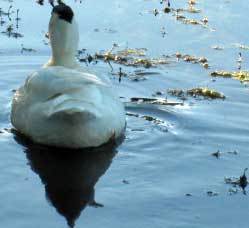

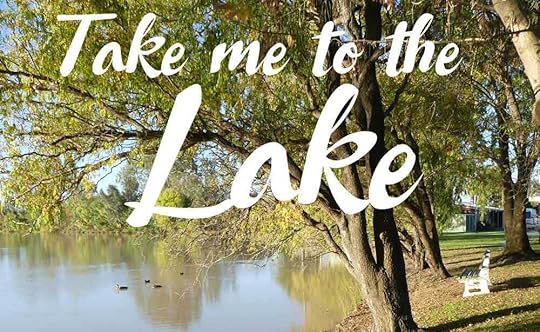 There are 170 Hectare of wetlands with rivergum forests in bushland reserves, in Northern Victoria and the southern Riverina http://users.mcmedia.com.au/~stocky/parks.html
There are 170 Hectare of wetlands with rivergum forests in bushland reserves, in Northern Victoria and the southern Riverina http://users.mcmedia.com.au/~stocky/parks.htmlOur late afternoon walk took us to the water edge of the Lake.
I tested out my new camera and I have been delighted with the results.
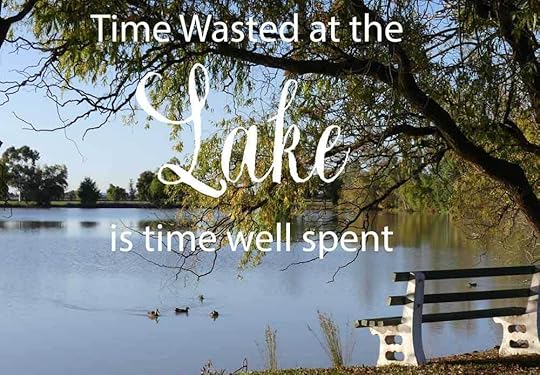 Lakes and waterways have always been a favourite location, not just for my walks, but for my on location paintings as well. Here are a few art favourites I've created that you will also find in my online art gallery and art print gift store.
Lakes and waterways have always been a favourite location, not just for my walks, but for my on location paintings as well. Here are a few art favourites I've created that you will also find in my online art gallery and art print gift store.
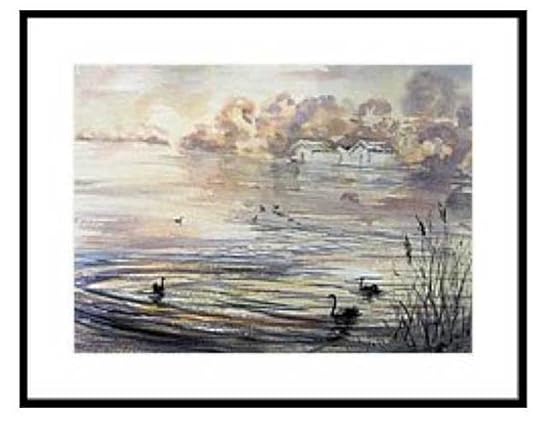 [image error]
Australian Rural-lit and historical fiction author and artist Ryn Shell
[image error]
Australian Rural-lit and historical fiction author and artist Ryn Shell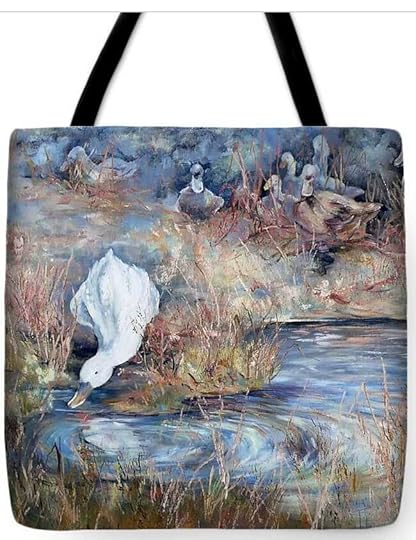 [image error]
[image error]
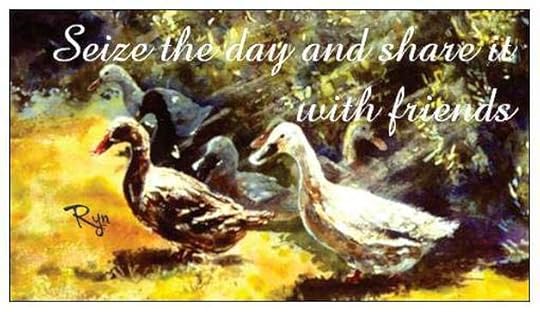 I send an invitation to my private online studio to my newsletter subscribers. You can invite friends too; they just need to join the newsletter subscribers to receive an invitation: Excerpt from the novel
I send an invitation to my private online studio to my newsletter subscribers. You can invite friends too; they just need to join the newsletter subscribers to receive an invitation: Excerpt from the novelStar Struck by Ryn Shell.
A Scene beside a lake.Beginning at Chapter Seven of Star Struck by Ryn Shell
At the sight of Brian and Jean Fife’s hopeless expressions, a feeling of dread hit Rose so strongly she almost collapsed to the ground. Linton’s arms encircled and lifted her back on to her feet.
Brian stepped forward, indicating with one hand for Linton to step back. He took over and supported Rose against him. His head bowed over Rose’s. “We found Carl’s footprints.”
Her eyes lifted, connecting to his, pleading.
“At the dam water’s edge,” Brian whispered hoarsely. “There’s a team of young people there. They will find him.”
Rose moaned softly. “He wouldn’t go in the water without me.”
Linton urgently asked, “Can he swim?”
“He learned to swim last summer. He will be all right.” Rose wrapped her arms about her head and rocked. “He’s got to be. He knows basic water safety rules. He knows to float on his back if he gets tired swimming.”
Linton had seen and heard enough. Not one for hanging around holding a pity party, and incompetent where it came to knowing how to fix screwed up human relationships, Linton chose action for his emotional release.
After a brief touch of this hand to Rose’s arm, he quickly blurted, “I’ll get him,” and he was off, racing downhill across paddocks.
Trevor and Rose followed, they long jumped over market garden beds and hurtled two fences rather than take the longer route via the gates to reach the dam.
By the time they arrived, the water’s edge was surrounded by volunteers. All the neighbours and many of the hill’s community had come to help.
The dam was a relatively large one for a small farm property due to a regularly topped-up supply of water from a local creek that flowed all of the time, aside from an occasional extremely dry season. Due to Rose and Trevor having preserved most of the natural surrounding rainforest, there was minimal evaporation; as such, their private dam provided a constant cool oasis in all seasons.
A green, damp natural-grass raised bank extended beyond the dammed area to an adjacent natural swamp, a sanctuary for bird life. The morning air filled with the high-pitched honking and squeals of birdlife. Small dry islands surrounded by swampy waterways provided safety from foxes and feral cats for the many water birds that made the area their home.
Now, in late autumn, the water course that flowed past the dam, on the other side of Rose and Trevor’s property boundary, had changed from a stream to a river.
“He’s here.” A bronze skinned, weather-worn man straightened up from a crouching position at the dam edge. The tracker had followed the trail of tiny fresh footprints from a bare-footed boy from the house to the dam.
“Without footwear…” He shook his head. “There’s no way he could clamber through the dense scrub…” He pointed up the hill. “The outer boundary, he couldn’t get through there so he wouldn’t have made it through to the river. Don’t waste time searching there, he’s here.” His eyes scanned the water. “He is here. Find him quick.”
“What if we don’t find him quick,” Trevor whispered. “Will he be lost to us in this mud?”
“If he’s in the water, a little boy like that will float to the surface in a day or so, when his body bloats up. We got to look for a survivor. Little boy’s playing Batman.” The tracker’s voice brightened. His eyes expressed tears and laughter lines. “He’s playing—having fun. He knows the water. His mum’s shown him.”
The tracker moved forward, doubled over. His eyes scanned places of soft moss and wild orchids without disturbing them. “He’s played here.” He pointed to a large treefern trunk lying horizontally on the ground. “He hid here.”
Linton, Rose and Trevor combed the bush near the dam edge.
“He’s a bright boy,” Trevor said striving to show confidence for Rose.
“I saw that.” Linton agreed as he emerged from beneath a bent treefern trunk. “He respects you.” He nodded his head to Rose. “He might be scared to show himself with this crowd around.”
Rose held back a branch to allow the brothers clear access to the entrance of a thicket of shrubs. “He wouldn’t have done more than paddle in bare feet. On a cold May morning he’d have been walking higher up the bank, not down in the cold mud and wet.”
Trevor called, “Carl! Where are you?”
A swan honked in reply. Black swans’ nests abounded; large mounds made of reeds, grass and sticks, many a metre-and-a-half wide and almost as high, dotted the edges of many mud islands.
Several of the nests were islands in themselves, set aside from the banks and totally surrounded by water.
Black swans colonised in groups on Rose and Trevor’s dam. Few of the searchers were showing any respect for the habitat. Men and women waded through the shadows, dragging sticks, stirring up mud. They waded to the bird sanctuary islands, dragging sticks through the reeds, disturbing and disintegrating nests. Carl’s tiny footprints were trampled over. Soon there was confusion amongst the searchers as to where the boy’s footprints had been before they had disappeared into the water.
Searchers called out and crawled into hollows, with total disregard for their personal comfort. Most were obsessed with the urgency of finding Carl. They poked into recesses and tore away shrubs.
The exploration of each mud island within proximity of the bank continued until barely a blade of grass remained attached to the soil. All that remained was flattened grasses covered in black mud as Brian and Jean, desolation evident on their face, led a group of volunteers back to the farm house for a cup of hot sweet tea and scone for refreshment.
The search for Carl had been underway for five hours by the early afternoon, and the once noisy swampland was silent. Not a bird could be seen. Several nests had escaped destruction and floated unanchored on the waterway. Boats arrived and were being part carried and partially dragged through the undergrowth and placed in the water for a search of the furthest islands. Everyone knew that such a search would be pointless. There was no way that a three-year-old child on foot could reach the bird islands in the centre of the dam.
Those with boats went back over every part of the waterway, dragging hooked sticks, lifting out snags, branches, any solid matter they could find under water.
In the late afternoon, Trevor’s partner Alvin approached with a basket. “Scones and tea?”
“Any water?” Linton asked.
“The tea’s sweet. It will give you energy,” Alvin said.
The two men eyed each other warily.
“Thanks, that’s just what we need.” Rose took the offered basket, set it on the ground, extracted three enamel mugs and filled them with black tea. She handed a mug to Trevor and Linton. “What are you hearing up at the house?”
“We’re as puzzled as you are about where he is.”
Rose’s voice raised in an urgent demand for information. “What are the police saying they think happened?”
Alvin hesitated.
Rose looked grim, her hands clasped in front of her. “What?”
“They don’t know…” Alvin’s voice trailed away. “They—they’re sort of hoping he might have been abducted—think that’s the best chance—”
“Chance of what?” Rose shrieked. “No one’s got my boy.” Trevor took Rose by the shoulders; Linton wanted to.
She shoved him away. “He wouldn’t go with a stranger and he didn’t drown.” She turned and yelled, “Carl! Carl! Carl!”
Linton looked uncertainly at the milky grey sky and then to Alvin. “Have you heard the weather for tonight?”
“Snowfall’s expected overnight below six thousand feet.”
The three of them—Linton, Rose, and Trevor—chucked their part filled mugs on the ground. They split off into different directions calling, “Carl! Carl! Carl!”
It was Linton’s idea to involve young children. The search organisers were horrified when he revealed the plan he’d formulated. But how to get the searchers to listen? Rose heard his voice raised over the sound of the worrywarts. She pushed her way through them to where Linton stood red raced and argumentative.
“Arguing isn’t going to help,” Rose addressed the cynics. “We’re all exhausted. I’ve walked every fence line, calling for my boy and looking for his footprints.” She shook her head, her chin thrust upward as if to defy gravity from allowing the moisture above her lower eyelid from flowing. “Trevor…” she reached for him, gripped his arm, “…he has walked every inch of this farm.” She turned to Linton. “You’ve done the hardest part, checking out the swamp, the dam and the rainforest water catchment.”
Rose startled everyone by flinging her arms around Linton’s neck and kissing his muddy cheek. Her arms remained around his neck, although she stepped back, drawing her body away from him. Tears unashamedly flowed as she said, “I don’t think I could cope if you were not here searching for our boy.” She released him suddenly and turned, blushing in embarrassment, burying her head in Trevor’s shoulder.
Hugging Rose, Trevor said, “Our efforts to find Carl are not working. What more can we—what else can we try?”
Rose drew away from Trevor and squared her shoulders. “Let’s do what Linton suggests.”
“The primary school is about to finish. Some of the searchers just left to pick up their children.” Linton’s expression pleaded. “We’ve got what?” He searched the faces of the search team leaders. “Two hours of daylight left at most?”
“The mountain shadow means it gets dark fast in the hills,” a searcher said.
A senior police officer pressed forward and stood beside Rose. “Official quitting time is in an hour and a half, although I for one will not leave until we find the boy.”
The room buzzed with agreeing voices.
“Quiet,” Rose clutched at Linton’s arm. “What do you want to do?”
“You, Trevor and me. Let’s get to the school gate fast and get as many parents with little children as possible to come and have picnic tea beside the dam.”
Mainly quizzical faces greeted Linton’s suggestion.
Rose’s face lit up with joy. “Yes!”
Trevor’s voice drowned out the protests and complaints. “Right, I want all adults aside from young women like Rose…” he grasped her hand, “off of my property—or at least out of sight, here in the house. I want my boy found and I don’t—” Trevor’s voice broke.
“He’s scared of all the commotion going on, and I think he’s hiding because he thinks he’s going to get into trouble.” Rose yelled, “That has to be it.” She tugged at both Linton and Trevor’s hands. “Doesn’t it?”
“I don’t know, honey.” Trevor put his arm around her chest and squeezed. “I hope that’s the case, and he’ll come out if he sees us having a picnic by the dam.” He turned with moist eyes to thank Linton for giving them renewed hope.
Linton was already leaping fences, racing across the country to his truck. He geared it for the downhill grade and drove towards the small schoolhouse in the valley.
The news report on the radio stated, “A group of volunteer bushwalkers from across the country are converging at a camp near the entrances to Sherbrooke Forest in the Dandenong Ranges tonight. They will begin a coordinated search at first light tomorrow.” Pause. “The police warn that given the expected overnight temperatures and the boy’s youth, this might be a recovery mission rather than a rescue.”
With his jaw locked firm, his brows pulled close, Linton turned the radio off.
Forced to stop at an intersection, Linton turned the radio back on. His heart leaped in hope at a familiar voice—one of the searchers being interviewed. “Hopes are slim that the lightly clad child could survive the night in the cold.”
Another voice: “He’s had no water or food with him. They are scaling back the search. Calling it off until daylight.”
Linton almost broke the knob on the radio with the force of his knob turn. “Time for the mums and their kids team to go in. We are not quitters.”
The mums and kids team gathered. The local mixed goods store owner, a friend of Rose and Linton, had supplied dress-up costumes and bags of sweet lollies for all the children.
Soon colourful rugs and picnic baskets dotted the bank around the dam. Children raced about, thrilled to be involved in trying to find a lost boy. They played cops and robbers, cowboys and Indians, Batman and Robin, and there were quite a few super girls whooping and calling out.
“Carl, come and play.”
“Have some of my sweets.”
“Be careful they don’t fall into wombat holes,” Linton said to a group of mothers.
“Trust us, our children know the bush, probably better than you do.” A woman in slacks and pale blue angora twinset tapped on a rug on the ground. “Sit down and relax. Isn’t that what you want to convey to Carl—a relaxed family picnic that is safe for him to come out and join?”
Linton scanned his eyes around. Rose and Trevor sat quietly together, about a hundred metres from him, eating sandwiches. They looked--close. He felt as if he were a stranger out of place.
“I trust you,” Linton mumbled. “Sorry.” He took a long steadying breath and closed his eyes. How could Rose and Trevor eat? His stomach felt hard as a rock with dread that he’d organised a stupid tea party that was costing them the last precious moments of daylight that might be Carl’s only chance to survive.
You stupid fool, Linton’s inner voice said. Stupid! Stupid man gambling with the ones you love! Must you keep destroying those who trust you enough to believe in you and follow your wild impulses? Why did Rose listen to me again?End of chapter seven excerpt from Star Struck by Ryn Shell.
Star Struck may be read as a stand alone novel as the story is complete within the one book.
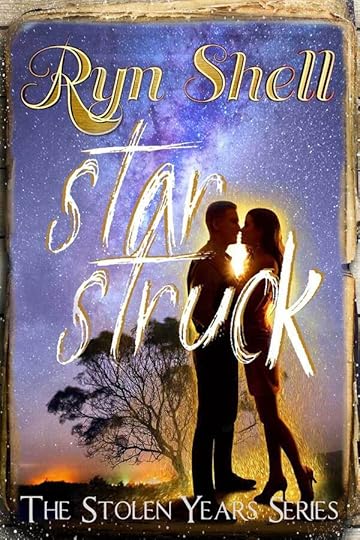 Get Star Struck by Ryn Shell hereExcerpt from the novel
Get Star Struck by Ryn Shell hereExcerpt from the novelStar Struck by Ryn Shell.
A Scene beside a lake.Chapter Eight of Star Struck by Ryn ShellWhy, Linton, why? Struggling with his guilt, Linton lowered his head, stood and shuffled away from the group of mothers and children. How could this happen after everything Rose and I have been through? Does she have to be punished more for what was never her fault?
The only men remaining near the dam were Linton and his brother Trevor. Linton believed, once this search was over, he should get into the truck and drive far away. Carl, when they found him—they must find him—never need know that Trevor wasn’t his father.
Linton’s body hurt from the effects of jarred muscles, reminders of climbing trees, squeezing between treeferns, and going where cautious searchers had avoided.
Rose would never know how having her say, “Yes!” to his suggestion and seeing her face light up when he’d given her renewed hope had affected him. Linton’s mind flew back to that last time when they’d been together without a chaperone—that time when he’d taken her as his own. Her love for him had made him feel as if he shone—he’d felt like he owned the heavens and earth for a brief moment when her eyes had told him she believed in him.
Rose blinked tears away as the fading light spread a silver gleam across the dam.
Mothers wandered solemnly past, clutching their own children’s hands and bidding farewell to Rose and Trevor. They sat, swigged down the last of a Thermos of cold coffee, nodding their thanks.
“You tried,” Rose said.
Trevor followed with, “We are so very grateful.”
Linton had sat, recovering from exhaustion, in the cabin of his truck for ten minutes. His troubled mind would not allow him to close his eyes and rest. He wanted, on the one hand, to gun the trucks engine and roar out of there and leave the fractured memories behind—but he could not turn the engine key. Destiny held him fast. There was too much left unresolved. It seemed like folly to stay, but he had to.
Carl will think like a child—what am I missing? Linton slid his legs over the side of the truck seat and leaped down. There was an urgency to his step. He sweated from exertion but was cooled by a chill breeze as he stepped into the open near the water, an unwelcome reminder that the hills were in the grip of a bitterly cold May. Rose and Trevor looked up and greeted Linton as if they’d expected him to join them.
“If he is alive…” Rose’s voice trembled, “…why haven’t we found him?”
“Maybe he is hurt, and they haven’t searched where he is,” Linton said.
“Maybe he was afraid, with so many searchers about. He isn’t used to crowds,” Trevor said. “Then, we might have been too quiet with our picnic. Suppose he’d taken a nap and didn’t hear us.”
“That could happen.” Linton nodded. He looked out to the mud islands. “How far out would he need to be for him not to hear the children playing?”
Linton walked into the water, his eyes fixed on a drifting swan’s nest. “Come and play with me,” he called. “Want to share my jelly beans and water?” Linton’s call brought no response, aside from the croak of frogs.
Rose waded into the water beside Linton. They clasped hands to steady themselves, then stood still watching and listening.
“We should go home,” Trevor called.
“Shush!” Rose replied.
Linton gazed with admiration at Rose. A film of sweat covered her brow, despite the descending cold night air. The hem of her shirt was untucked, muddy and torn. There were dried blood stains on her hands—she’d not been a passive observer of the search. Linton longed to hug her—say he still loved her. “You did well,” he said. “You tried.”
Trevor waded into the water beside Rose and patted her shoulder. “I’ll take you home.”
“Shh,” Rose whispered. “Listen and look.”
Linton fumbled in his pocket for a pen torch and shone it out over the water. “Please come out and play with me.”
“I’ll give you a piggyback home,” Trevor called out in a faked cheerful tone with a strange choked-back chuckle at the end of it.
“Yuck!” Rose mouthed the word and swiped several leeches off Linton’s arm.
He gripped Rose’s hand and strode out to waist deep in the water. They were at eye level with an anchored-in-place by reeds, swan’s nest.
“We will have to get home soon,” Trevor said. “This is crazy.”
“We can’t go much further.” Rose released Linton’s hand and waded further into the dam. Linton illuminated her with the torch light, moving ahead so he could shine the light on her face.
He was there as she slipped, grabbing and steadying her—somehow managing to clasp on to the penlight. She reached out and grasped his outstretched hand.
Linton held her hand firm. “You can’t go any further.”
They stood still, shivering, until their feet, hands and lower legs had gone numb. Disheartened, they turned to retreat.
A black swan honked.
Rose and Linton swung around; the sound was close. The black swan moved, drifting in the water. The black mound in the nest was silhouetted against the moonlight.
Linton gasped. Rose’s sudden leap forward almost caused him to drop the torch. He caught it before it hit the water.
The mound in the swan’s reed-island nest moved.
A weak voice carried across the water to Carl’s three overwhelmed parents. “I want to go home.”
What had appeared to be an extended swan’s neck became a frantic flailing arm.
Rose grabbed the torch and Linton rushed forward wading through the water with his arms out ready to scoop little, lost Batman into them. Rose caught up to him. The lake surrounds rang with their joyous laughter, whispered soothing reassurances, the deep-throated protest and flapping wings of disturbed waterfowl.
The boy, Carl, rose unsteadily, his teeth chattering. Trevor was on an adrenalin high of excitement. He whooped and hollered, the sounds piercing the night, bringing many from the day’s search party racing back to find the boy embraced within the arms of his family—Linton, Rose and Trevor.
~~~
“Great job,” Linton said into his rear-view mirror. He gunned the engine for real. He’d not overstay his welcome this time. Having last seen the boy wrapped in his brother’s arms and convinced that Rose did not know she and Carl were always on his mind and in his heart made his pulse thump.
Envy or rage? Why now? He’d not felt those emotions in years. Discovering he was still attracted to Rose, experiencing that surge of love for Carl, that was no reason to hate Trevor. He should be done with such childish stuff. He needed a shower.
Parking close to residences, Linton slipped into a side garden. He stripped and hosed the muck from the dam off his body. Holding the bundled filthy clothes, he streaked back to the truck, imagining neighbours peering through the slats of their Venetian blinds. He chuckled at the thought of them trying to focus on his face and identify the looney man in the dim light. Better get out of the town before the police come for me.
The cold shower had cleaned up his foul mood and he, both shivering and grinning, relived the elation as his outstretched arms had grasped and lifted his son from the birds nest mound.
As he changed into clean clothes in the truck cabin, the radio news report announced that astronauts had successfully repaired the heat shield on Skylab and that a missing lad had been found safe and well on his parents’ property. There would be snowfall as low as six thousand feet. Linton drove forward cautiously. He needed to get out of the mountains before there was black ice on the roads.
Rose, I’m so proud of you and our kid. I’m so glad that you have my brother Trevor looking after you both. I’ll always love you, but I’ll not return and risk interfering in your life again. Carl doesn’t need the confusion of finding out Trevor isn’t his daddy.
~~~
Rose lay on top of the double bed, where she had carried Carl in her arms. She held him tight, stirring only when Alvin covered mother and child, from the neck down, with a blanket.
“How could he leave me again, after all that we’ve been through? How could he leave me…” Her voice trailed away to a broken sob.
Alvin darted to the front door and grabbed the car keys off the hook. Trevor already had the door open.
~~~
When the snow started to fall, Linton pulled the truck over into a wide road verge and stopped for the night. Then he crawled into the bed, straightened out the mess that had been made there during the search for Carl, and went to sleep.
Linton imagined that he lay with her once more and they had their son Carl between them. Though partly in a dream state, he was acutely aware of the sensation of touch, and he could have sworn it was real. In his fantasy, they were together on a sultry summer’s evening, and Rose’s arms reached across Carl to stroke his body. That was what he wanted—needed, to lie with them both and celebrate just being together, complete as a family. The native wattle trees flowered out of season. They swayed their golden blooms overhead. Golden yellow, the colour to celebrate homecoming—his and Carl’s return. He was home to stay.
He fell deep into a dream of their future, their lives together, the farm, and more children. He saw a daughter in their future, and it was all confused with Skylab. Some spaceship wanted to take him away from those he loved. It was bashing on the sides of his truck, flashing light, trying to break in and get him on board, take him away.
The noise wasn’t Skylab or Rose and Carl. Linton flicked his eyelids open—wide awake. The thumping on the door was real, as was his sweat. Peering through his window was Trevor and the man Linton recognised as his friend, the one who’d helped provide the search teams with refreshments.
“The district doesn’t have to know what goes on at our place,” Trevor said as Linton wound down the window.
Linton braced against the cold rush of air.
A young man thrust his manicured hand towards Linton. “Alvin’s the name.”
“I know who you are.” Linton scowled.
“Get your arse back to the house where it’s needed,” Alvin said. “It’s too cold to stand and argue with you here.”
“Rose and Carl both need you.” Trevor crouched to line his eyes up to Linton’s.
“We can all talk about it in the morning. Just get home where you belong.”
~~~
Linton studied the small freckle-faced boy, with the angelic blond hair, asleep in Rose’s arms. Tiny tapered fingers, ethereally beautiful, as his mother was of nature and earth.
He gathered up a quilt and cushion from the lounge room, returned to her room, quietly slid an armchair beside the bed and settled in, with no intentions of sleeping, his insides curled with the desire to hold them both.
He’d loved her at fifteen. In all fairness, she was almost sixteen and at the age of consent when they first loved. It was evident that she was a loving mother. Now he hoped that he too would have a chance to laugh with his boy at play, soothe his tears and get to know him well before he grew too old for cuddles. Between them, Rose and he has created something perfect from the mess of their teenage years.
He would make the separation of the last few years up to them and do everything in his power to give Rose and Carl the love and security he owed them. His shoulders slumped in peace. At twenty-one, Linton had come home and had begun the process of making peace with himself by assuming responsibility for others.
~~~
Rose, Linton and Carl spent the day doing farm chores together, not forcing things, just developing friendship and the adults hiding their growing love. Carl was more demonstrative and begged for hugs and piggyback rides.
As Rose lifted Carl on to Linton’s back, she experienced tingling excitement, attraction and confusion. She had no plans to allow him just to walk into her life and think that nothing had changed. Just the same, with Carl so happy in Linton’s company she refrained from telling him not to assume he could snap his fingers, and she’d come to him again. As the day wore on, and they sat beneath an early flowering almond tree to allow Carl to rest across both their laps, Rose found herself longing to lie against Linton. She willed that he’d slip his arm around her waist and she’d be able to excuse not brushing him away so as not wishing to awaken Carl.
~~~
Linton decided to wait until the following evening before hitting them with what he suspected. Alvin served the evening meal, a beef stew, right on cue for Trevor to arrive home and have time to wash and change into clean clothes for dinner. Rose put Carl to bed early and opened a bottle of red wine, leaving it to breathe.
“You’ve been very quiet over dinner,” Trevor said. “What have you been mulling over?”
“I need to talk to you.” Linton took a half slice of bread and mopped his plate with it. “Alvin, this…” he popped the bread in his mouth. “Hmm.” He looked at the remains of the meal with appreciative eyes. “Too good to leave a drop.”
“Well, what is it you want to say?” Trevor asked.
“I haven’t seen the account books yet, so I’m just going on what I’ve seen on the farm and the garden journals…”
Alvin scraped plates together.
Trevor took a long swig of wine. “And?”
Linton said tremulously, “You haven’t told me that you were in financial trouble. I need to know the extent of it so I can tell if my recovery plan will work.”
Rose and Trevor exchanged glances. Alvin busied himself, his head bowed over the sink.
“What have you told him?” Trevor’s face clouded over as he looked accusingly at Rose. “You might have filled me in about this first. I’ve just about busted my gut making this dream of yours stay afloat.”
“Your dream, remember!” Rose’s voice rose. “Peonies. They don’t flower well enough in a mild year, they get fungal disease when it’s humid, and you used so many chemicals to prevent the fungus that I lost my organic grower’s certificate, and that quartered the value of my berry crop.”
Linton gripped Rose’s hand, engaging her storm-coloured grey eyes and gently willed her to stay calm. She swung around to him, her chin thrust up. “You can’t just walk in and undermine us. You don’t know what we’ve been through.”
“I’ve been providing you with the funds to build your business for years.” Linton rose from the table. “Where has the money gone?” His glare directed itself to Trevor.
“I didn’t want Rose worried when I didn’t always make a profit selling flowers at the Queen Vic Market,” Linton yelled. “And you weren’t here. I was the one putting up with Rose’s moods.”
“My what?” Rose yelled.
Carl’s footsteps patted down the hall towards the kitchen. He stood looking confused in the doorway.
Linton lifted Carl. “Piggyback ride to bed.” He left Rose and Trevor arguing at the kitchen table. Emerging, after he’d read Carl a story and his boy was asleep, he asked Rose, “Did you know I was writing several times a month and sending you money?”
The question was unanswered in words as Rose turned on Trevor, calling him every gutter word she could think of.
Over the following week, Linton slept on the sofa at night and spent most of his daylight digging out fifty per cent of the ornamental flowerbeds—Trevor’s side of the farm. Trevor had to rush to keep up with him, collecting the plants before they wilted, replanting some, bulk selling others at discounted prices to move them fast.
“I’ve completed the weeding,” Linton announced once a quarter of the property had been cleared of perennials. He sat at the table with Carl watching him remap out the border between what was considered Trevor’s Perennial Nursery and what was the existing Rose’s Berry Farm.
“I’ve left you with the smaller parcel of land with the house on it.” Linton presented Trevor with a land title transfer document granting three quarters of the land that Rose’s parents had gifted to Trevor to be legally placed into Rose’s name.
Trevor took one look at the dark, unyielding expression on Linton’s face and signed the document.
Alvin’s face was pale. “If we own the house…” The only outward sign of the fury within. He came and stood close to Trevor.
“Not now,” Trevor said quietly.
Linton glanced over to where Rose was sitting, silently studying him. It was the first he’d seen of her dimples since she’d been fifteen. If he wasn’t already smitten by her, he believed he could have fallen in love all over again. “Rose, do you agree that the funding priority and all our efforts should be to get both the perennials and the berry businesses on their feet?”
She crossed her legs in an easy, relaxed manner, and her eyes seemed to speak to him as she gazed across the top of the wine glass she held at her lips. Then she nodded her head and her eyes told Linton she wasn’t thinking of business.
“And then we’ll move out?” Linton stood, came to Rose and touched her hair.
Rose stood beside him, her dimples twitching. “We will separate the businesses, then build our own home and family.” She walked to the doorway of the master bedroom. She turned and held out her hand for Linton to come to her.
End of chapter eight excerpt from Star Struck by Ryn Shell.
Star Struck may be read as a stand alone novel as the story is complete within the one book.Get Star Struck by Ryn Shell here
Published on June 30, 2025 07:00
May 31, 2025
Wildflowers in the Outback of Australia, Western Australia
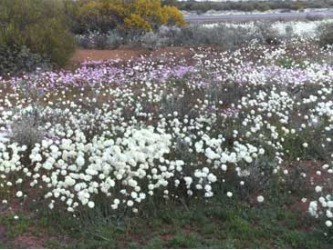
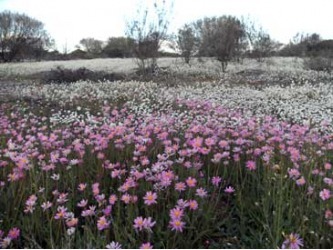


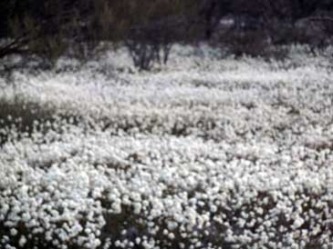

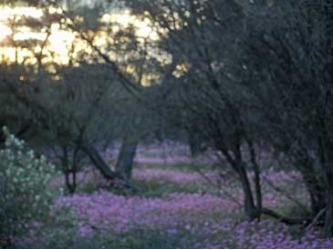
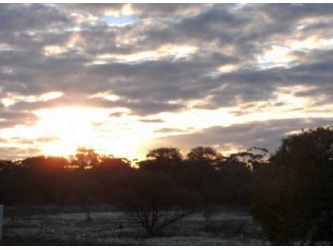
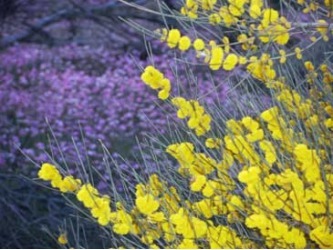 Camp spot 22 km NE of Wubin or 131 km SW of Paynes Find, just north of Rabbit Proof Fence, Road.
Camp spot 22 km NE of Wubin or 131 km SW of Paynes Find, just north of Rabbit Proof Fence, Road.There is good internet and mobile phone connection here, and we are now only 40 km from Dalwallinu, our next stop to exhibit.
Excellent wildflowers in the area, the pink ones are highly fragrant but attract mosquitoes at dawn and dusk and in shady places so wear a protective covering if outside at these times or in these conditions. Gibber, rock- and pebble-littered area of arid or semi-arid country in Australia. The rocks are generally angular fragments formed from broken up duricrust, usually silcrete, a hardened crust of soil cemented by silica (SiO2). The gravel cover may be only one rock fragment deep, or it may consist of several layers buried in fine-grained material that is thought to have been blown in. A gibber is generally considered a result of mechanical weathering because silica is almost inert to chemical weathering.
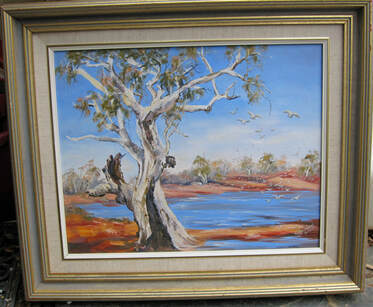 We had our first rain since we left Victoria in April this year, today. As I am now in the wildflower area of Western Australia, I almost welcome the rain as the wildflower show depends on it. It is still warm even though we have now traveled a long way south and are only a day’s drive from Perth although we will not be near Perth until the start of September.
We had our first rain since we left Victoria in April this year, today. As I am now in the wildflower area of Western Australia, I almost welcome the rain as the wildflower show depends on it. It is still warm even though we have now traveled a long way south and are only a day’s drive from Perth although we will not be near Perth until the start of September.
Published on May 31, 2025 07:00
April 30, 2025
Choosing a business name
 Okay, so we’ve started our journey to set ourselves up as a legitimate on-line entrepreneur. We’ve decided what it is we are good at, what our passion is and what other people might consider worthy of paying for our services, for. The something, as you may recall, in my case, was editing/proofreading and all thing bookish. Step number one out of the way, so what’s step number two on our journey to riches?
[image error]
What are you going to call yourself?
Okay, so we’ve started our journey to set ourselves up as a legitimate on-line entrepreneur. We’ve decided what it is we are good at, what our passion is and what other people might consider worthy of paying for our services, for. The something, as you may recall, in my case, was editing/proofreading and all thing bookish. Step number one out of the way, so what’s step number two on our journey to riches?
[image error]
What are you going to call yourself?How important is the name of your little cottage industry?
Actually, it’s probably more important than you initially give it credit for. Now, if you’re anything like me, secretly a little vain and proud, your initial instinct will be to put your own personal name into your business name... but is this the best thing? To start with, I certainly thought it was and I toyed with some sparkling variations of my name, as possibilities for my new business enterprise. I tried: Grant’s Author Services, Leishman’s (very descriptive), Leishman’s Author Services, and even just the simple, Grant Leishman. The more I looked at it, though, the more amateurish (and even try-hard) I felt it looked. Yes, there is some value in having your own name in your personal business name, in some instances, but in my opinion, there were better reasons not to use my own name. It is a personal decision though and my advice is to go with what your gut tells you – feels good. It actually hit me, like a ten-ton locomotive that I already had a business that was using my own name! I was Grant Leishman – Author and that was my brand. It made absolute sense that I wouldn’t want my “author” persona being mixed up with my “editing” persona. The two skills (writing and editing) are two completely different skill sets and I decided that I needed to keep them totally separate, including the name. I then started looking at a variety of other options. The two most important things, when considering what to call your business, it seemed to me were; 1/ The name should be descriptive enough that a casual browser could see your business name on a website somewhere and immediately grasp the type of service you were offering; and 2/ Not to pick a name that would genuinely confuse or mislead potential customers (there’s nothing more annoying to a potential client than for them to click a link thinking they were going to a particular business or type of business and finding out, in fact, that they’d been a little duped). Under this section I would say, don’t choose a name that sounds or looks very familiar to a well-known business or brand. e.g. calling your business MacDonald’s not only potentially infringes their trademark or brand (and you might get sued) but it also confuses potential customers who think they’re going to a fast-food website to order dinner. Your name should reflect what you do and that’s about it, really.
So, I looked at some names that I felt described the services I was offering, including; Author Support Services, Author Support Centre, Author Resource Centre and some slightly crazier ones like, Editing Is Us (potential trademark infringement there – Toys R Us etc), Editing 4 U, Books, Books, Books., Book Services etc etc etc. How did I finally choose Author Resource Centre as the name for my new business?Well, I sat down and thought, “what are the two things every online business MUST have?
1/ A website and 2/ An email address.
I didn’t want to have differing names for both, so it was important to me that I had a website URL that said www.authorresourcecentre.com (or whatever name it was that I chose) and an email address that said authorresourcecentre@gmail.com or whatever other email service provider I had decided to use, such as hotmail, yahoo. Always conscious of my limited budget, I knew initially I wanted to use one of the free email hosts, in my case Gmail. So, before I decided on choosing a name, I put my potential options to the test, making sure I could get both the URL and the email address, before I committed. As it happened, my first choice for a name, Author Support Services, not only had an unfortunate acronym (ASS) but was also not available as a URL (it was already taken). After some experimentation, I concluded that Author Resource Centre was both suitable and available – VOILA! My new business was born.
With the second step completed, my next task was to build me website, which I’ll talk about in my next instalment. Until then, keep dreaming and keep working toward your goals.
Remember – “You don’t have to have big dreams, but if you don’t, then big dreams can’t come true.”
Grant Leishman.
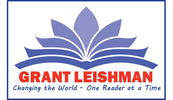 I love that Grant Leishhman doesn't pump out formula plots, as I love originality. As he is a proofreader, you can be certain his books are skillfully written. You'll be certain to enjoy them. I've not been paid no express this opinion of Grant Leishman's books or for promoting them here. I do this to encourage great writing talent.
I love that Grant Leishhman doesn't pump out formula plots, as I love originality. As he is a proofreader, you can be certain his books are skillfully written. You'll be certain to enjoy them. I've not been paid no express this opinion of Grant Leishman's books or for promoting them here. I do this to encourage great writing talent.Cheers, Ryn Shell, author and artist.
Published on April 30, 2025 07:00
How to Paint a Lady & Dogs in Watercolour
Dogs portrait tutorial in watercolour & extra-soft pastels - golden retriever - YouTube Video 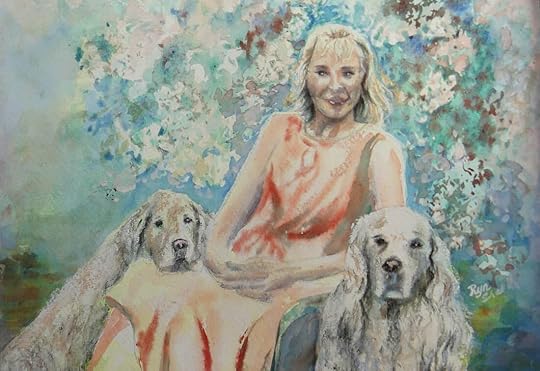
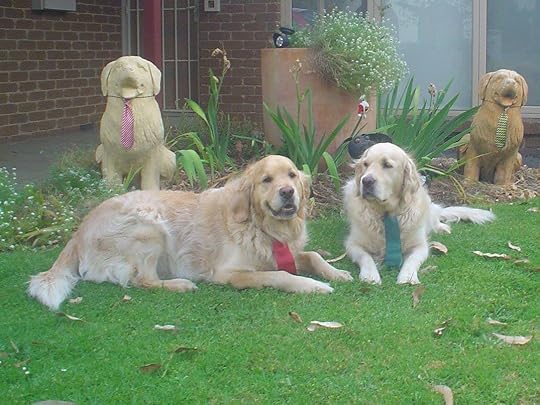
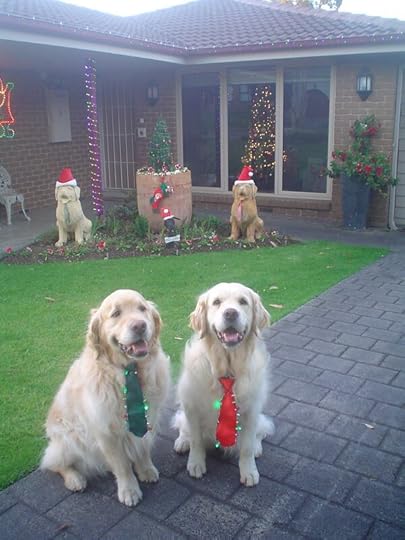
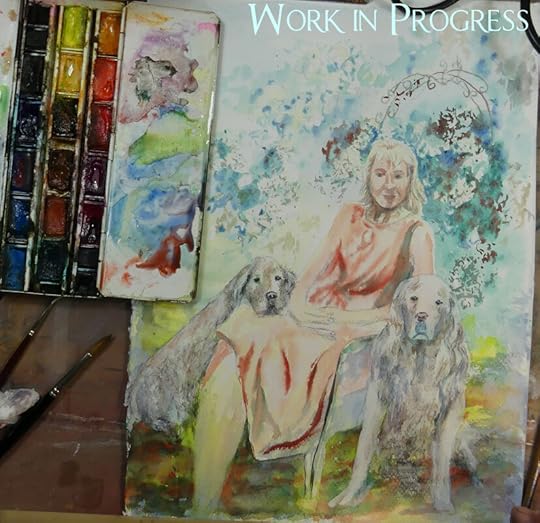 A lot still to do in the attempt to pull this off, but progressing well.
A lot still to do in the attempt to pull this off, but progressing well.
I needed to take a couple of days off from painting this work to look into improvements to my YouTube, Website and Patreon tutorial delivery.
Back to the painting the next stage of the Carla in the Rose Garden Tutorial for you.
Feel welcome to ask questions.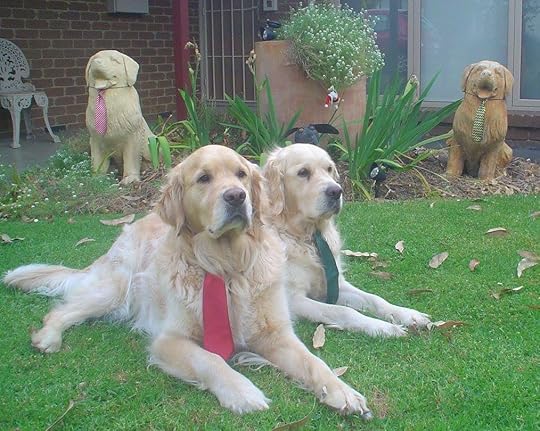 .
. 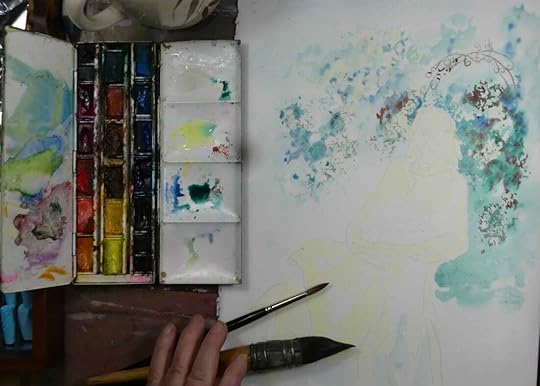 Yes, I completed the watercolour stage of this artwork after 18 videos.
Yes, I completed the watercolour stage of this artwork after 18 videos.
However the work wasn't completed. It still 'called to me,' telling me things that were needed.
I enthusiastically switched over to using half a dozen extra soft pastels and I tested out several blending tools. I'll get the edit for that part of the artwork to you next week. I take this part of the week, to write my blog, create my YouTube video/s and perhaps share short posts with you, but the coming video to bring the artwork to this stage is a longer one.
I love the combination of watercolour with a touch of extra-sot pastels for the completion of figurative work in the landscape I have been working this way for decades. What do you think? Do you like combining art mediums?



 A lot still to do in the attempt to pull this off, but progressing well.
A lot still to do in the attempt to pull this off, but progressing well.I needed to take a couple of days off from painting this work to look into improvements to my YouTube, Website and Patreon tutorial delivery.
Back to the painting the next stage of the Carla in the Rose Garden Tutorial for you.
Feel welcome to ask questions.
 .
.  Yes, I completed the watercolour stage of this artwork after 18 videos.
Yes, I completed the watercolour stage of this artwork after 18 videos. However the work wasn't completed. It still 'called to me,' telling me things that were needed.
I enthusiastically switched over to using half a dozen extra soft pastels and I tested out several blending tools. I'll get the edit for that part of the artwork to you next week. I take this part of the week, to write my blog, create my YouTube video/s and perhaps share short posts with you, but the coming video to bring the artwork to this stage is a longer one.
I love the combination of watercolour with a touch of extra-sot pastels for the completion of figurative work in the landscape I have been working this way for decades. What do you think? Do you like combining art mediums?
Published on April 30, 2025 07:00
February 23, 2025
Farmyard Grampians, Original Acrylic Painting by Ryn Shell
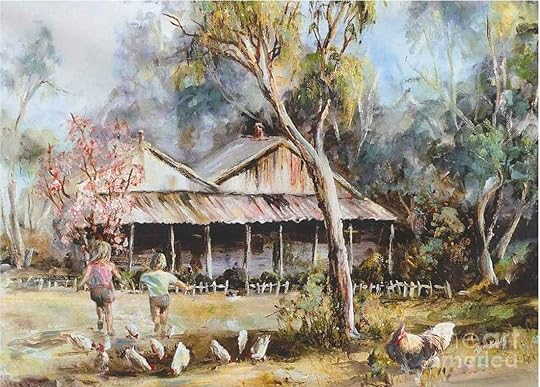 Farmyard with rooster, hens, children and fruit tree in blossom, with farm house, near Halls Gap, Grampians, Victoria, Australia, Oil on canvas by Ryn Shell.
Farmyard with rooster, hens, children and fruit tree in blossom, with farm house, near Halls Gap, Grampians, Victoria, Australia, Oil on canvas by Ryn Shell.Close up


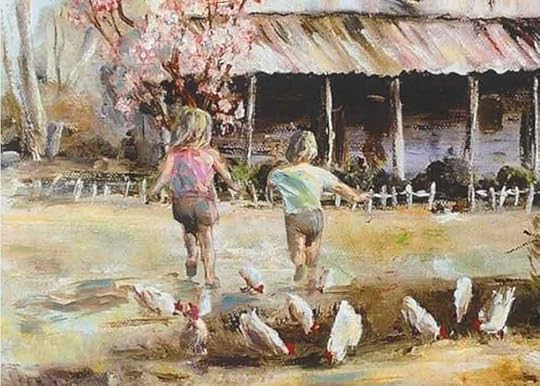

Published on February 23, 2025 05:00
A fabulous Western Australian Art Gallery, complete with a ghost.

 I am at the Dalwallinu Show in Western Australia today, It’s a small friendly country show, in the Northern Wheat belt of Western Australia. This photo above is of wildflowers from the Dalwallinu area. Flowers supplied by the Western Roads Board who were at the show to educate about safe driving on Western Australian roads.
I am at the Dalwallinu Show in Western Australia today, It’s a small friendly country show, in the Northern Wheat belt of Western Australia. This photo above is of wildflowers from the Dalwallinu area. Flowers supplied by the Western Roads Board who were at the show to educate about safe driving on Western Australian roads.
 This area is also famous for its wildflowers, and the show was a mixture of field days with huge farming machinery on the oval for viewing and orders and a craft market with many local craftspeople both exhibiting and selling their wares. It was a lovely day despite rain showers.
This area is also famous for its wildflowers, and the show was a mixture of field days with huge farming machinery on the oval for viewing and orders and a craft market with many local craftspeople both exhibiting and selling their wares. It was a lovely day despite rain showers.
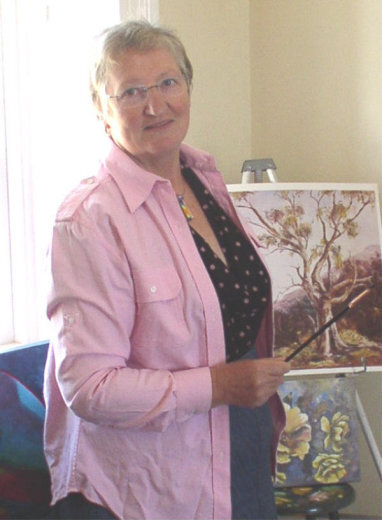
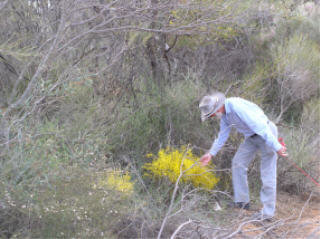 Tonight there is a concert being held on the grounds for the locals.
Tonight there is a concert being held on the grounds for the locals.Tomorrow we head toward Toodyay in the Avon Valley. That town is special to me, I have good friends there, and it is a beautiful town, one I would like to spend time painting one day, maybe next year.
Next year I plan to 'freelance,' travel without any show or exhibition bookings, just trust what blows in on the winds of luck.
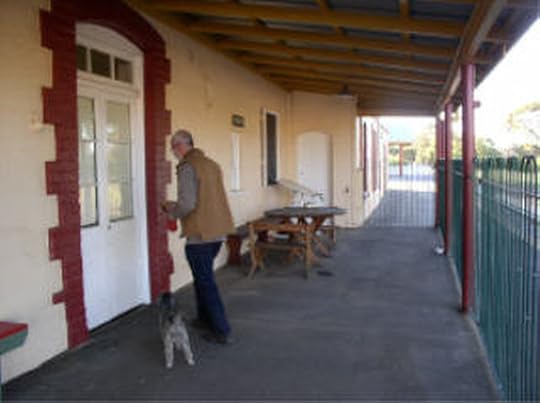 Above, Reg opening the Beverley Station Gallery.
Above, Reg opening the Beverley Station Gallery.
Last year I stayed most of September in the beautiful Avon Valley as the Artist in Residence at the beautiful Beverley Railway Station Gallery.
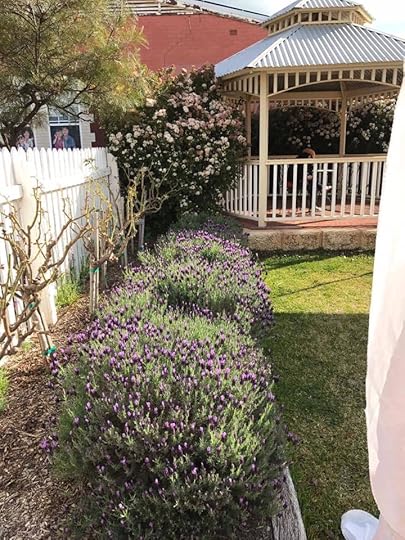 The Station Gallery Courtyard.
The Station Gallery Courtyard.
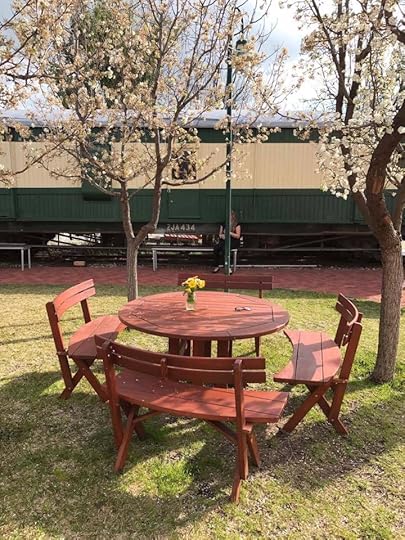


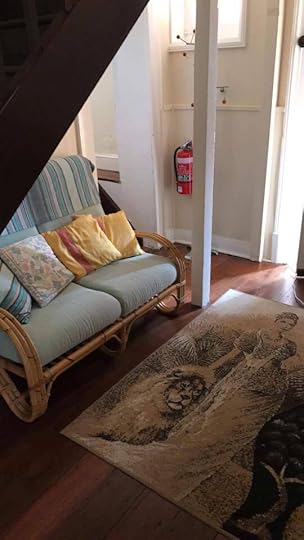 The cosy manager's quarters in the Beverly Station Gallery.
The cosy manager's quarters in the Beverly Station Gallery.  Above, art work by acclaimed artist and author, Ryn Shell, a former guest artist and manager of the Beverley Station Gallery, now exhibiting with Fine Art America.
Above, art work by acclaimed artist and author, Ryn Shell, a former guest artist and manager of the Beverley Station Gallery, now exhibiting with Fine Art America.
 Beverley Station Arts and Platform TheatreLocated in the centre of Beverley, the Station Gallery & Platform Theatre is the heart of the Arts community in the town.
Beverley Station Arts and Platform TheatreLocated in the centre of Beverley, the Station Gallery & Platform Theatre is the heart of the Arts community in the town.The Station Gallery is home to the Shire of Beverley community art collection.
An Artist in Residence program runs from the old station masters residence, culminating in several Exhibitions each year.
More information
Open Thursday to Sunday, 11.00 am - 3.00 pm. Closed through the month of January.
120 Vincent St, Beverley
Ph: 0419 040 063
 [image error]
[image error]
Published on February 23, 2025 05:00
January 30, 2025
Which Fountain Pen Supplies to Choose?
#wsite-video-container-975579337218815643{ background: url(//www.weebly.com/uploads/b/1987672-1488... } #video-iframe-975579337218815643{ background: url(//cdn2.editmysite.com/images/util/video... } #wsite-video-container-975579337218815643, #video-iframe-975579337218815643{ background-repeat: no-repeat; background-position:center; } @media only screen and (-webkit-min-device-pixel-ratio: 2), only screen and ( min-device-pixel-ratio: 2), only screen and ( min-resolution: 192dpi), only screen and ( min-resolution: 2dppx) { #video-iframe-975579337218815643{ background: url(//cdn2.editmysite.com/images/util/video... background-repeat: no-repeat; background-position:center; background-size: 70px 70px; } } 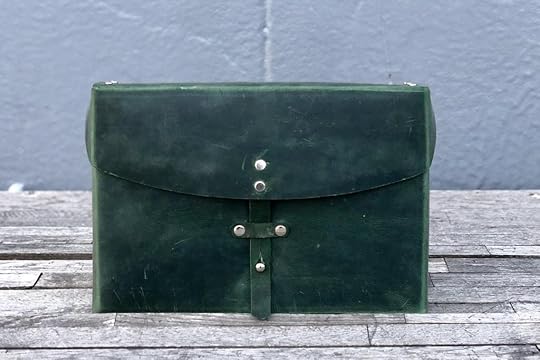 The Galen leather bag is just stunning. Have been lusting after that myself since I first saw it.
The Galen leather bag is just stunning. Have been lusting after that myself since I first saw it.
Not sure I'll ever be granted an unlimited spend up again for art supplies. 😄 Last night, a seller accepted my 'offer' on a vintage Montblanc. The nib design looks to be the same as the Lamy 2000—who copied who? I'll be interested to test it beside the Lamy 2000. I'm loving using my Lamy 2000 pens in a painterly way.
Yes I have (that colour) writer's bag, very handy indeed! Love their products - I have some of their brass things and a pencil sharpener, and another A5 zipped notebook cover with a couple of TR notebooks on order, not expecting them for a few weeks yet. All ways happy with their stuff, has an old fashioned quality and feel to it! Love it!
$2000. Budget
A $2,000. spend up, a gift for a coming birthday.
This leather writer's bag—which I first saw and lusted after here.
Many gold nibbled vintage pens.
Lamy 2000 (my preferred pen) in BB to complete my set of every size. For sketching, I adore Lamy 2000. I dislike anything that has a cartridge or converter insert—not enough ink in those for my artwork.
I will have some good pens to resell—when I get around to it.
A5 sketch and Watercolour pads and A5 leather cover.
Some brass fittings for bag, ruler etc.
My favourite DE ATRAMENTIS Permanent Document *Ink in white, grey and two shades and hue variations of brown.
Colour sample sets of two other ink brands, total 16 colours.
Beginning to collect all of the dye based Van Dieman's Inks.
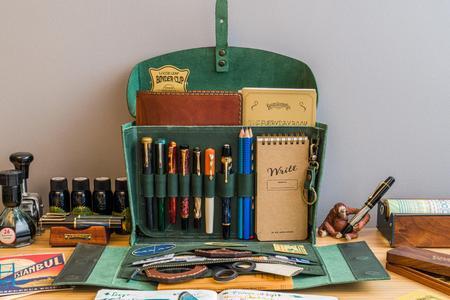 Boots Gully
Boots Gully
Set of three Australian Sketchbook ink line and watercolour wash artworks underway featuring an old gold miner's gully with what I think from the look of the timbers in black wattle, or it might be Cootamundra wattle. I will ask around and find out. It should look effective when finished with the soft blue-green foliage, the yellow blooms, against the black tree branches—then of course, all the boots. It is called Boot's Gully, and Australians have a wicked sense of humour. I'm painting one of the works tilted sideways to add to the quirkiness of the scene.
 Which Fountain Pen Nib to Choose?
Which Fountain Pen Nib to Choose?
If you write small, go with an EF
For the normal writer, F is the most popular
If you tend to lean on a bigger font, M will be perfect
B is for statements!! Sign a check in B, write a header in B, do some coloring/shading in B
 The Galen leather bag is just stunning. Have been lusting after that myself since I first saw it.
The Galen leather bag is just stunning. Have been lusting after that myself since I first saw it.Not sure I'll ever be granted an unlimited spend up again for art supplies. 😄 Last night, a seller accepted my 'offer' on a vintage Montblanc. The nib design looks to be the same as the Lamy 2000—who copied who? I'll be interested to test it beside the Lamy 2000. I'm loving using my Lamy 2000 pens in a painterly way.
Yes I have (that colour) writer's bag, very handy indeed! Love their products - I have some of their brass things and a pencil sharpener, and another A5 zipped notebook cover with a couple of TR notebooks on order, not expecting them for a few weeks yet. All ways happy with their stuff, has an old fashioned quality and feel to it! Love it!
$2000. Budget
A $2,000. spend up, a gift for a coming birthday.
This leather writer's bag—which I first saw and lusted after here.
Many gold nibbled vintage pens.
Lamy 2000 (my preferred pen) in BB to complete my set of every size. For sketching, I adore Lamy 2000. I dislike anything that has a cartridge or converter insert—not enough ink in those for my artwork.
I will have some good pens to resell—when I get around to it.
A5 sketch and Watercolour pads and A5 leather cover.
Some brass fittings for bag, ruler etc.
My favourite DE ATRAMENTIS Permanent Document *Ink in white, grey and two shades and hue variations of brown.
Colour sample sets of two other ink brands, total 16 colours.
Beginning to collect all of the dye based Van Dieman's Inks.
 Boots Gully
Boots GullySet of three Australian Sketchbook ink line and watercolour wash artworks underway featuring an old gold miner's gully with what I think from the look of the timbers in black wattle, or it might be Cootamundra wattle. I will ask around and find out. It should look effective when finished with the soft blue-green foliage, the yellow blooms, against the black tree branches—then of course, all the boots. It is called Boot's Gully, and Australians have a wicked sense of humour. I'm painting one of the works tilted sideways to add to the quirkiness of the scene.
 Which Fountain Pen Nib to Choose?
Which Fountain Pen Nib to Choose?If you write small, go with an EF
For the normal writer, F is the most popular
If you tend to lean on a bigger font, M will be perfect
B is for statements!! Sign a check in B, write a header in B, do some coloring/shading in B
Published on January 30, 2025 05:00



